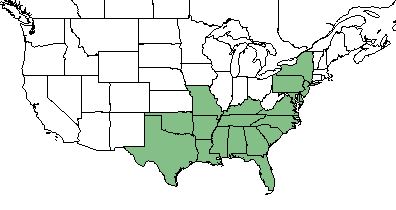Difference between revisions of "Chasmanthium laxum"
(→Conservation and Management) |
(→Ecology) |
||
| Line 36: | Line 36: | ||
<!--===Seed dispersal===--> | <!--===Seed dispersal===--> | ||
<!--===Seed bank and germination===--> | <!--===Seed bank and germination===--> | ||
| − | + | ===Fire ecology=== <!--Fire tolerance, fire dependence, adaptive fire responses--> | |
| + | ''C. laxum'' is not fire resistant. <ref name= "USDA Plant Database"/> | ||
<!--===Pollination===--> | <!--===Pollination===--> | ||
===Use by animals=== <!--Herbivory, granivory, insect hosting, etc.--> | ===Use by animals=== <!--Herbivory, granivory, insect hosting, etc.--> | ||
Revision as of 18:26, 18 May 2018
| Chasmanthium laxum | |
|---|---|
Error creating thumbnail: Unable to save thumbnail to destination
| |
| Photo from USDA NRCS Plants Database. | |
| Scientific classification | |
| Kingdom: | Plantae |
| Division: | Magnoliophyta - Flowering plants |
| Class: | Liliopsida - Moncots |
| Order: | Cyperales |
| Family: | Poaceae |
| Genus: | Chasmanthium |
| Species: | C. laxum |
| Binomial name | |
| Chasmanthium laxum (L) Yates | |

| |
| Natural range of Chasmanthium laxum from USDA NRCS Plants Database. | |
Contents
Taxonomic Notes
Synonyms: Uniola laxa (Linnaeus) Britton, Sterns, & Poggenburg; Chasmanthium laxum var. laxum
Varieties: none
Description
C. laxum is a perennial graminoid of the Poaceae family native to North America. [1]
Distribution
C. laxum can be found along the southeastern coast from Texas to New York. [1]
Ecology
Habitat
C. laxum can be found in savanna-pocosin ecotones, sandhill-pocosin ecotones, moist hardwood swamps, and other moist habitats. [2]
Phenology
C. laxum flowers in June and July. [3]
Fire ecology
C. laxum is not fire resistant. [1]
Use by animals
C. laxum serves as a minor food source for large mammals and terrestrial birds. [1]
Conservation and Management
C. laxum is listed as an endangered species by the New York Department of Environmental Conservation, Division of Land and Forests, and the Pennsylvania Department of Conservation and Natural Resources. [1]
Cultivation and restoration
Photo Gallery
References and notes
- ↑ 1.0 1.1 1.2 1.3 1.4 USDA Plant Database https://plants.usda.gov/core/profile?symbol=CHLA6
- ↑ Weakley, A. S. (2015). Flora of the Southern and Mid-Atlantic States. Chapel Hill, NC, University of North Carolina Herbarium.
- ↑ PanFlora Author: Gil Nelson URL: http://www.gilnelson.com/PanFlora/ Date Accessed: 5/18/18